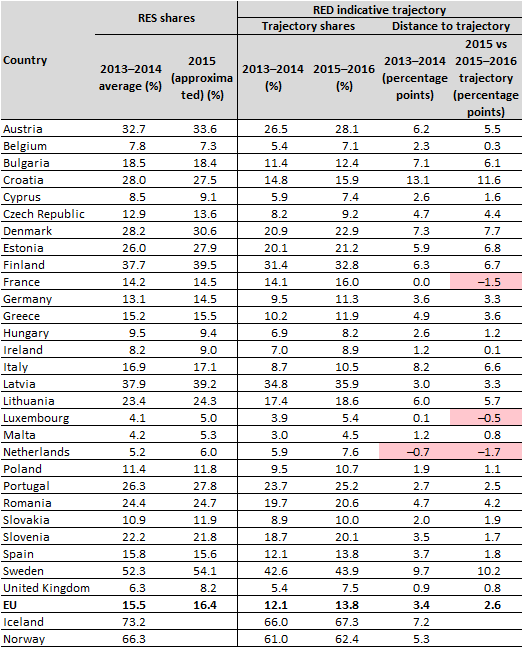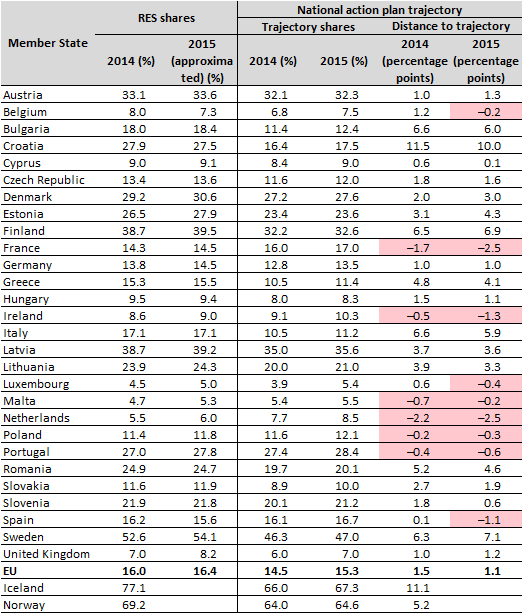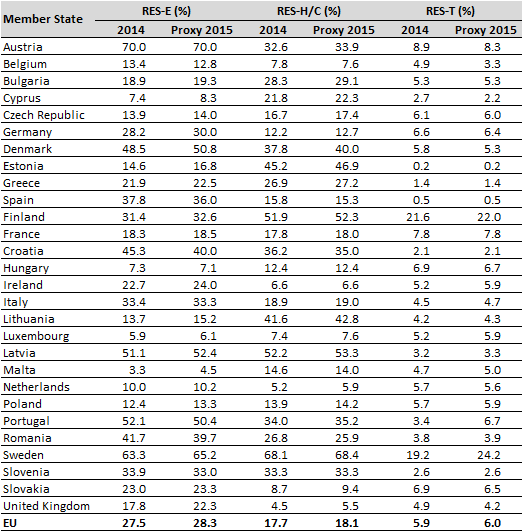1 Reporting requirements related to renewable energy
Under the Renewable Energy Directive (RED), Member States need to report on their progress towards the deployment of energy from renewable sources (EU, 2009). Reporting under the RED takes place biennially in a standardised format. Furthermore, under the Energy Statistics Regulation, Member States also report data on their renewable energy deployment to Eurostat.
2 Data sources related to renewable energy deployment
The analysis presented in this report is based on several sources relating to renewable energy use in Europe.
Historic trends for the share of energy from renewable sources in gross final energy consumption
The assessment of progress towards objectives and targets for the use of energy from renewable sources (RES) is, for the most part, based on information reported by Member States to Eurostat under the Energy Statistics Regulation and the RED, and published by Eurostat via its SHARES tool (Eurostat, 2016).
Share of RES in gross final energy consumption in 2014
The shares of RES in gross final energy consumption in 2014 were estimated by Eurostat, based on national data transmission under Regulation (EC) No 1099/2008 on energy statistics (EU, 2008). In accordance with the accounting rules in the RED, electricity generated by hydro and wind power were normalised to account for annual variations (hydro over 15 years and wind over five years). For details on the normalisation rules, see the SHARES manual provided by Eurostat (Eurostat, 2016). Because of their insular and peripheral geography, Cyprus and Malta’s gross inland consumption is disproportionally high for aviation, and they are thus strongly affected by current technological and regulatory constraints. Therefore, they have exemptions with regard to the amounts by which they exceed the EU’s average gross final consumption of energy in aviation in 2005 as assessed by Eurostat, i.e. 4.12 %.
Approximated shares of renewable energy use in 2015
The approximated shares of renewable energy use in 2015 were estimated by the EEA and will be published in early 2017 (EEA, forthcoming).
The 2020 RES targets and indicative trajectories for the period from 2011 to 2018
The 2020 RES targets for each Member State were taken from Part A of Annex I of the RED, and the indicative trajectories for the 2011–2018 period were taken from Part B of Annex I of the RED (EU, 2009).
Anticipated national RES trajectories for the period from 2010 to 2020
Anticipated national RES trajectories for the 2010–2020 period were derived from information submitted by Member States to the European Commission in 2010, in the context of their national renewable energy action plans (NREAPs). These trajectories reflect how Member States themselves anticipate their renewable energy deployment to develop up to 2020 (EEA, 2011; EC, 2013).
The shares of energy from renewable sources on a sectoral level
The report also presents data on RES use on a sectoral level (for electricity, heating and cooling, and transport). These data are based on Eurostat’s SHARES tool (Eurostat, 2016). Approximate 2015 values were estimated by the EEA (EEA, forthcoming).
3 Tracking progress towards renewable energy targets
The progress of Member States towards their targets under the RED is assessed by comparing the share of energy from renewable sources in gross final energy consumption with two sets of indicative targets for the period until 2020:
- indicative targets set under the RED, which are always defined for a period of two years (e.g. for 2013/2014 and 2015/2016);
- anticipated renewable energy deployment as reported in NREAPs via the anticipated NREAP trajectories on a yearly basis.
Assessments of progress take place using the following methodology:
- A Member State is considered on track (green)if:
- its average 2013/2014 share of energy from renewable sources matched or exceeded its indicative 2013/2014 RED target;
- its 2014 share of energy from renewable sources reached or exceeded its anticipated NREAP trajectory.
- A Member State is considered not on track (yellow) if it did not reach its anticipated NREAP trajectory in 2014.
- A Member State is considered not on track (orange) if its average 2013/2014 share of energy from renewable sources was below its 2013/2014 indicative RED target.
Table A2.1 Current progress towards indicative trajectories under the RED

Note: A distance to trajectory is calculated as ‘RES share’ – ‘RES target’. A positive value indicates a RES share higher than the relevant interim target.
Source: EU, 2009; Eurostat, 2016; EEA, forthcoming.
Table A2.2 Current progress towards national action plan trajectories

Note: The distance to a trajectory is calculated as ‘RES share’ – ‘RES target’. A positive value indicates a RES share higher than the relevant interim target.
Source: EC, 2013; EEA, 2011 and forthcoming; Eurostat, 2016.
Table A2.3 RES shares per sector, 2014 and 2015

Note: RES-E: energy from renewable sources for electricity production; RES-H/C: energy from renewable sources for heating and cooling; RES-T: energy from renewable sources in the transport sector.
The values for 2015 are approximated estimates from the EEA.
Source: Eurostat, 2016; EEA, forthcoming.



Document Actions
Share with others